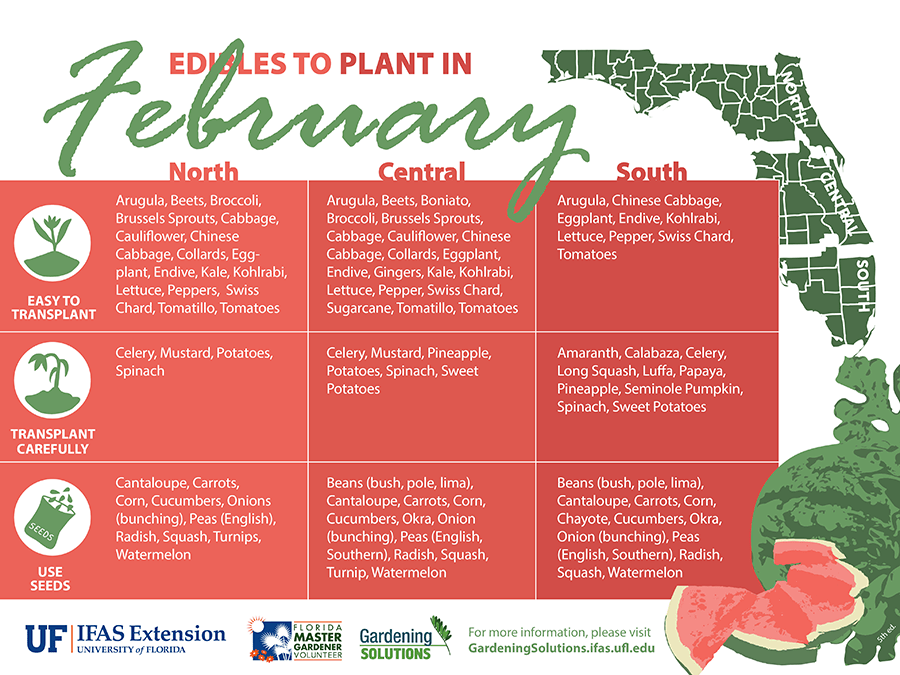Are you ready to grow sweet, crunchy carrots right in your Florida garden? Knowing the best time to plant carrots can make all the difference between a bountiful harvest and a disappointing crop.
Florida’s unique climate means timing is everything when it comes to planting root vegetables like carrots. Whether you’re a beginner or have tried growing carrots before, understanding when to sow your seeds will help you get the best results. Keep reading to discover the perfect planting windows, helpful tips, and tricks tailored just for Florida gardeners like you.
Your freshest carrots are just a few steps away!
Planting Seasons In Florida
Carrots thrive in Florida’s unique climate, but planting times vary by region. Understanding the planting seasons helps gardeners grow healthy carrots. Planting at the right time ensures good root development and sweet flavor. Soil conditions and temperature play important roles in carrot growth.
North And Central Florida Timeline
In North and Central Florida, plant carrots from August through March. The cooler months allow carrots to grow slowly and develop better taste. Avoid planting during the hot summer months because high temperatures cause poor root growth. Prepare the soil by loosening it well before sowing seeds. Water consistently to keep soil moist but not soggy.
South Florida Timeline
South Florida’s warm climate lets you plant carrots from September to March. The mild winters provide ideal conditions for root crops. Avoid planting during the hottest and most humid months of summer. Use sandy, well-drained soil to prevent rot. Regular watering supports steady carrot development. Harvest carrots before temperatures rise in spring to maintain sweetness.
Soil And Sunlight Needs
Carrots need the right soil and sunlight to grow well in Florida. Healthy soil helps roots grow long and straight. Enough sunlight gives energy for strong plants. Understanding these needs improves your carrot harvest and quality.
Ideal Soil Conditions
Carrots prefer loose, sandy soil that drains well. Heavy clay or rocky soil can make roots grow crooked. Before planting, loosen soil with a fork or shovel to reduce compaction. Remove stones and debris to avoid obstacles for growing roots. A slightly acidic to neutral soil pH between 6.0 and 6.8 works best. Keep soil moist but not waterlogged to prevent root rot. Adding organic matter like compost improves soil texture and nutrients.
Sun Exposure Requirements
Carrots need at least six hours of sunlight daily for best growth. Full sun helps carrots develop sweet flavor and good color. They can tolerate partial shade but will grow slower and smaller. In Florida’s hot climate, some afternoon shade can protect carrots from extreme heat. Choose a planting spot with morning sun and light afternoon shade if possible. Consistent light helps plants produce healthy leaves and strong roots.
Choosing Carrot Varieties
Choosing the right carrot variety plays a big role in your garden’s success. Different types grow well in Florida’s unique climate. Picking varieties that match your planting time helps you harvest fresh carrots faster and easier. Focus on carrots that fit the season and your soil conditions for the best results.
Fast-maturing Types
Fast-maturing carrot varieties are ideal for Florida gardeners. They grow quickly and are ready to harvest in about 50 to 60 days. These types reduce the risk of heat stress during Florida’s warmer months. Popular fast-maturing carrots include ‘Thumbelina’ and ‘Nantes.’ They perform well in loose, sandy soil and provide sweet, tender roots.
Choosing fast-maturing carrots allows for multiple plantings in one year. You can start seeds every few weeks from late summer to early spring. This way, you keep fresh carrots coming through different seasons. Their shorter growth period fits Florida’s long growing season perfectly.
Varieties Suited For Fall And Winter
Fall and winter seasons in Florida offer cooler temperatures that carrots love. Varieties like ‘Bolero’ and ‘Danvers 126’ thrive in this period. These carrots develop better flavor and texture with cooler soil. They mature in about 70 to 80 days, making them perfect for a fall planting.
These varieties resist pests and diseases common in Florida’s wetter months. Planting them in September through December ensures a good harvest before spring heat arrives. Preparing the soil well and watering consistently boosts their growth during these cooler months.

Credit: www.reddit.com
Preparing Your Garden Bed
Preparing your garden bed is a key step before planting carrots in Florida. Carrots grow best in soil that is loose and free of obstacles. This allows their roots to grow straight and strong. Taking time to prepare the soil improves your chances of a healthy harvest.
Soil Loosening Techniques
Carrots need soft soil to grow well. Use a digging fork or garden shovel to loosen the soil deeply. Break up large clumps and mix the soil to make it light. Avoid compacted soil because it can cause carrots to grow misshapen or stop growing. Loosen the soil to at least 12 inches deep for best root development.
Removing Rocks And Debris
Rocks and debris block carrot roots and can cause them to fork or split. Remove all stones, sticks, and hard objects from the soil. Rake the area smooth to create a clean bed. This step helps carrots grow straight and makes harvesting easier. Clean soil means healthy roots and better crops.
Planting Tips For September
September is a great month to start planting carrots in Florida. The weather begins to cool down, giving carrots a better chance to grow well. Planting in September can lead to a good fall or winter harvest. The soil is still warm, which helps seeds sprout faster.
Here are some important tips to help you plant carrots successfully in September.
Seed Sowing Methods
Plant carrot seeds directly in loose, sandy soil. Sow seeds about ¼ inch deep. Space seeds 1 to 2 inches apart in rows. Thin seedlings to 3 inches apart when they grow. This helps roots have enough room to develop. Use a rake to cover seeds lightly with soil. Keep rows about 12 to 18 inches apart for easy care.
Moisture Maintenance
Keep the soil moist but not soaked. Water gently after planting to settle the soil. Carrot seeds need consistent moisture to sprout well. Water deeply once or twice a week. Avoid letting the soil dry out. Mulch around plants to keep moisture in and reduce weeds. Moist soil helps carrots grow straight and tender.
Season Extension Strategies
Use row covers to protect young carrots from pests and cold nights. Row covers also keep soil warm to speed growth. Plant fast-maturing carrot varieties to harvest before heavy frost. Start seeds indoors to get a head start, then transplant seedlings. Add compost to soil before planting for better nutrition. These steps help you enjoy fresh carrots longer into the season.

Credit: gardeningsolutions.ifas.ufl.edu
Frost Considerations
Frost plays a key role in deciding when to plant carrots in Florida. Carrots can tolerate some cold, but hard frost can damage them. Understanding frost patterns helps gardeners choose the best planting time. This section explains frost dates and how frost affects carrot growth.
First Frost Dates In Florida
Florida has a mild climate, but frost dates vary by region. Northern Florida usually sees the first frost between late October and early November. Central Florida’s first frost often occurs in November or December. South Florida rarely experiences frost, and if it does, it is usually light and brief.
Knowing your area’s average first frost date helps protect your carrots. Plant carrots so they mature before hard frost arrives. This timing avoids frost damage and ensures a healthy harvest.
Frost Impact On Carrots
Carrots are hardy but not frost-proof. Light frost can sweeten carrots by turning starch into sugar. Heavy frost or freezing temperatures can harm the roots. Frozen soil stops carrot growth and may cause rot when thawing.
Protect carrots from hard frost by using row covers or mulch. Harvest carrots before hard frost hits to avoid loss. In frost-prone areas, plant carrots early enough to mature in warmer weather.
Common Mistakes To Avoid
Planting carrots in Florida can be very rewarding. Avoiding common mistakes helps ensure a healthy crop. Many gardeners rush the process or ignore key details. These errors can stunt growth or ruin your harvest.
Improper Timing Of Planting
Planting carrots too early or too late harms growth. Carrots prefer cooler months in Florida. Start seeds from August to March in North and Central Florida. In South Florida, plant from September to March. Planting outside these times may cause poor root development.
Ignoring Soil Preparation
Carrots need loose, sandy, well-drained soil. Hard or compacted soil causes twisted, stubby roots. Use a digging fork or shovel to loosen soil deeply. Remove stones and debris to avoid misshapen carrots. Proper soil helps roots grow straight and long.
Overwatering Or Underwatering
Carrots need consistent moisture but dislike soggy soil. Overwatering causes root rot and disease. Underwatering leads to dry, woody roots. Water evenly to keep soil moist but not soaked. Mulching helps retain moisture and keeps soil cool.
Planting Carrots Too Close Together
Crowding carrot seeds causes competition for nutrients. This results in small or deformed roots. Space seeds about 2 to 3 inches apart. Thin seedlings when they sprout to allow room for growth. Proper spacing improves air circulation and root size.
Neglecting Sunlight Requirements
Carrots need at least 6 hours of sunlight daily. Partial shade slows growth and reduces sweetness. Choose a sunny spot for planting. Avoid shaded areas near tall plants or structures. Good sunlight promotes healthy, flavorful carrots.

Credit: www.revivalgardening.com
Frequently Asked Questions
What Month Do You Plant Carrots In Florida?
Plant carrots in Florida from August to March in North and Central regions, and September to March in South Florida for best growth.
What Is The Trick To Growing Carrots?
Plant carrots in loose, well-drained soil with full or partial sun. Keep seeds moist and thin seedlings for straight roots.
Do Carrots Like Sun Or Shade When Planting?
Carrots prefer full sun with at least 6-8 hours daily. They tolerate partial shade but grow slower. Choose well-drained, loose soil for best results.
Can I Plant Carrots In September?
Yes, plant carrots in September using fast-maturing varieties. Ensure loose, moist soil and check your region’s frost dates for best results.
Conclusion
Plant carrots in Florida from late summer through early spring. Choose loose, well-drained soil for best growth. Sunlight helps carrots mature faster but partial shade works too. Pay attention to your local frost dates for timing. Fast-maturing varieties suit shorter seasons well.
Regular watering keeps the soil moist and roots healthy. With proper care, you can enjoy fresh carrots almost year-round. Start planting at the right time and watch your garden thrive.

